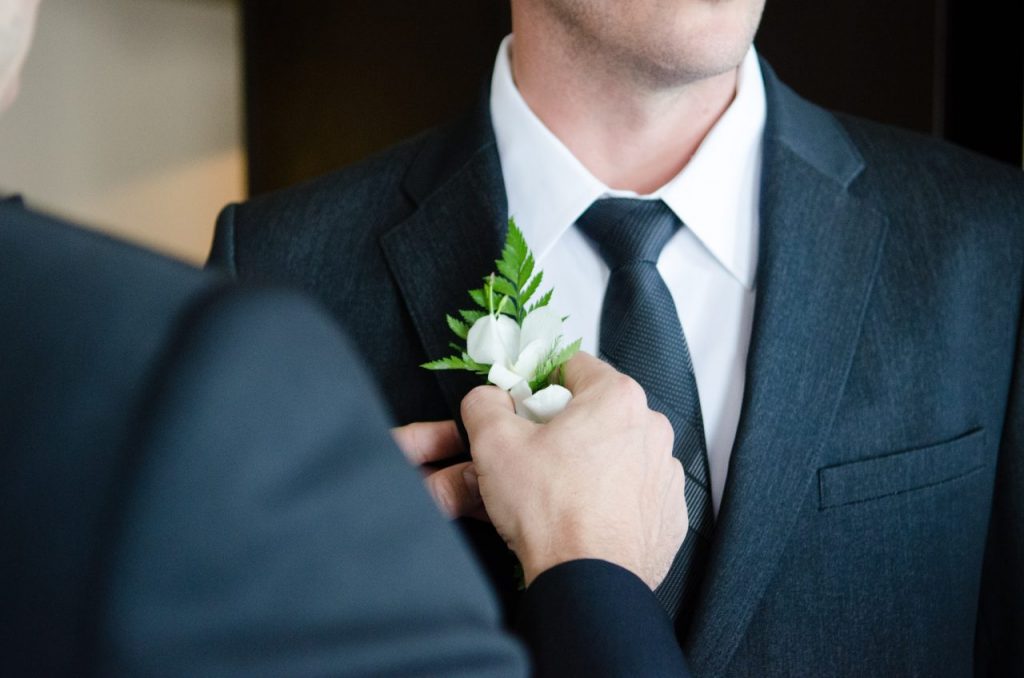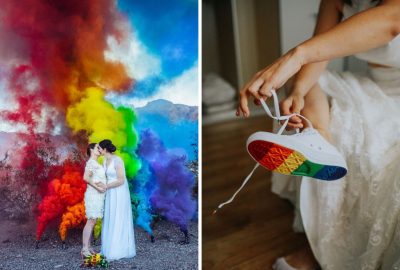Planning a wedding can be overwhelming when you think about all the decisions you’ve got to make. As a same-sex couple, you may have lots of questions about how to make your wedding feel like your own when so many traditions are aimed at heterosexual couples. Today we’ve picked six traditions to ditch for your same-sex wedding. We’ve provided details about where these traditions come from and some fabulous alternatives for you to consider! The general message we’ve got for you today is this: you do you. Choose the traditions you want to keep and ditch the others. Sit down together and work out what you want your wedding to look like!
Traditions to ditch for your same-sex wedding
The proposal
In a same-sex marriage, you might be wondering “who asks whom?”. It’s a valid question with a simple answer: it’s up to you! Below, we’ll break down the tradition, its origins and some alternatives to consider.
Tradition: The groom requests permission from the bride’s parents to marry her. He then pops the question with a surprise proposal that usually involves him getting down on one knee and giving the bride a ring.
Origin: Requesting permission is a tradition that lots of couples (both heterosexual and LGBTQ+) are choosing to ditch. The origins are complicated, but the story involves bartering and parents making sure the groom can take care of the bride. Getting down on one knee is an old medieval tradition, where knights would bow before their noblewoman. And the engagement ring could be looked at as an engagement gift or a sign of a formal agreement to marry.
Alternatives: As we advise all couples, you do you. Where gender roles are fluid, you might not feel the need to get down on one knee. This is a personal choice that’s totally up to you. If it feels right, go for it, but don’t feel obliged. As couples explore their equality, you may want to tell your partner’s family that you intend to propose, instead of requesting their permission. As for an engagement ring, who gets one? The one being proposed to? Both of you? That’s entirely up to you! You may prefer to exchange some other type of engagement gift, like a watch, or get matching tattoos instead. Another fabulous idea is to plant a tree and look after it together as a demonstration of the way you nurture your relationship.
The wedding party
Who gets bridesmaids and groomsmen? Do we need a Maid of Honour and Best Man? What do we call these roles?
Tradition: The wedding party is there to support the couple. Traditionally, the bride selects her closest female friends (her bridesmaids) and her sister or best friend (Maid of Honour). The groom will choose his closest male friends (his groomsmen) and his brother or best friend (Best Man). Heterosexual and LGBTQ+ couples are already throwing this out the window by mixing it up! If you’re a woman with a close male friend or brother, who says he can’t be in your wedding party?
Origin: The historical reason for having a wedding party is a little crazy and involves bridesmaids distracting the groom so he won’t know which of them is the bride.
Alternatives: Genders shouldn’t define the role people play in your life and on your wedding day. Choose those closest to you and invite them to be part of your crew. They don’t even have to be called bridesmaids or groomsmen. What about ‘wedding party’, ‘wedding attendants’ or something else you love, like ‘bride squad’ or ‘I do crew’. Our expert tip is to make sure that the roles are clearly defined, so everybody knows what they’ve been asked to do.
Wedding location: Castello di Montignano | Photographer: Andrea Cittadini
The hen and stag do
Should we celebrate separately? What happens if we share the same friendship group?
Tradition: The Maid of Honour and bridesmaids plan a hen party (AKA bachelorette/bridal shower) while the Best Man and groomsmen plan a stag do (AKA bachelor party). The bride’s celebration is a ladies-only event, while all the men celebrate with the groom.
Origin: This party signifies your last night of freedom before getting married (talk about archaic).
Alternative: There’s nothing overly heterosexual about having a pre-wedding celebration. You may want to refresh this tradition by having a joint party if your friendship groups overlap. Lots of couples are straying away from things they deem as tacky, and we’d advise anybody to have a hen/stag party that’s their style. Strippers not your thing? Don’t have them. A weekend away too much for you? Don’t do it. Are you into ziplining and other adventurous activities, why not ask your wedding party to organise a fun day out for you and your friends instead!
Walking down the aisle
Who walks down the aisle? Do we need to have a parent take part in this?
Tradition: The groom waits at the top of the aisle, while the bride, escorted by her father, walks down the aisle towards him.
Origin: The origin of this tradition is steeped in the idea that women are property. The father gives her away as a sign of a transfer of ownership (yuck).
Alternative: How you handle this is really up to you (can you sense a theme here?). Sit down and work out what you want to do. Would one of you like to wait at the top of the aisle while the other walks down the aisle? Do you both want to walk down the aisle, either separately or together? If you go separately, would you like to have a parent, sibling or friend walk with you? There are lots of beautiful options to choose from and some wonderful ways to honour different people in the process.
Garter and bouquet
Tradition: The groom removes the bride’s garter and tosses it to all the single men. The bride tosses her bouquet to all the single women. Sometimes the person who catches the garter and the person who catches the bouquet are made to dance together awkwardly (personally, not a fan of this).
Origin: Historically, guests would get rowdy and start following the couple to their wedding bed. The couple would toss the bouquet and garter to appease or distract them.
Alternative: What you choose to do here is largely based on preference and what you’ve chosen to wear/hold. At a same-sex wedding you may have two bouquets, two garters or neither. Side note: grooms, please don’t feel like you can’t hold a bouquet, because you totally can! Lots of heterosexual and LGBTQ+ couples have ditched this tradition altogether (I did!). It’s entirely up to you! You could deliberately wear a rainbow garter, or instead of tossing the bouquet, you give it to somebody as a gift.
Wedding attire
Who wears the suit and who wears the dress? Could we have both/either/neither?
Tradition: The groom wears a suit (and so do the groomsmen) and the bride wears a white dress (with the bridesmaids wearing dresses too).
Origin: Typically, a white wedding dress is a symbol of purity, although the truth is that the white wedding dress was made popular by Queen Victoria in the mid-19th Century.
Alternative: Ladies, you can both wear a dress if you want to. Your dress can be white or something else! And it doesn’t have to be a dress if you’d rather wear a jumpsuit or suit. Gents, you can both wear suits! And you don’t have to. While we’re at it, your outfits don’t have to be a surprise either (unless you really want that!). How about shopping together and choosing outfits that match or complement one another? Basically, wear what you want to your same-sex wedding!







